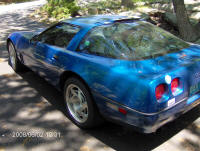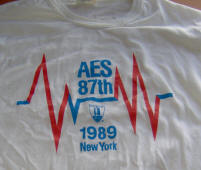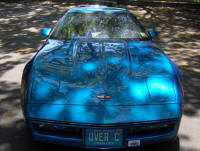RIKLBLOG
|
| Tomorrow |
| 17 April 2009 |
| Yesterday |
| Index |
| Eventide |
| SETI League |
| PriUPS Project |
| Bonus! |
| Contact |


Cold Fusion Insanity
The Definition of Insanity
It was allegedly Albert Einstein who came up with this excessively repeated quote: The definition of insanity is doing the same thing over and over again and expecting different results.
It was also Albert Einstein who said "God does not play dice with the universe" and who never quite believed quantum theory. As far as the succeeding generations of physicists know and believe, Einstein was wrong about quantum theory. Furthermore, theologians tend not to be proscriptive about divine activities, as many believe they will eventually find out the Truth and prefer not to be chastised as only that Great Player of Craps can do it. And, of course, Einstein was wrong about insanity as well. Whoever said "if at first you don't succeed, try, try again" was much closer. Have you ever tried to load a web page? Dilbert's pointy-haired boss has, and he found out that if it doesn't work for a while, just try the same thing over and over again and maybe it will. So have I, so have you. Which brings us to "cold fusion."
Is Cold Fusion Real?
That great eccentric, Wayne Green, believes in it. He even started a magazine devoted to it. Even better, my friend "Rudolfo" is always emailing references to CF "experiments" in which something or other is accomplished or proved. Most scientists, for sound reasons of physical theory, think it's nonsense. Why, then, when it is only accredited by admirable, engaging eccentrics and discredited by the not-insane, is it pursued so avidly? Three reasons:
-
Einstein was wrong about insanity.
-
Sound reasons of nuclear physics theory, at least known nuclear physics theory, may also be wrong or at least incomplete.
-
Notwithstanding the continual discouragement, success would guarantee such desiderata as energy independence for every country (and, hopefully, individual) and a Nobel prize for its discoverer.
At the present state of research and theory, cold fusion is chimerical. Real scientists performing careful experiments cannot reproduce the stigmata of a fusion reaction—the production of neutrons and energy. And yet, once in a while, a real scientist performing a careful experiment does claim to see the production of neutrons and excess energy.
I am inescapably reminded of another experimental result in a different field, one in which I have a more than passing interest. That would be SETI, the Search for Extraterrestrial Intelligence, and the "experimental result" is the "Wow signal" which, so far as anyone knows, could have been a true but brief collection of photons from ET, but also could have been earthly interference or a temporary glitch in the receiving apparatus. Without more information, now unobtainable, there will never be a way to be sure. Is cold fusion in a similar state? The majority of CF experiments produce null results; every once in a while they "succeed" but convince nobody since science is based on reproducible phenomena. With SETI, most people, scientists included, believe that ET exists based on statistical and non-geocentric arguments, and are eager for actual, reproducible proof. With cold fusion, most people want to believe, suspicious in itself. Because of the circumstances surrounding SETI, proponents are able to keep looking on the reasonable basis that the "search space" has hardly been tapped. But with CF, the "search space," a laboratory experiment that should be easily reproducible turns out not to be such.
Reproducible or Not?
How do we reconcile the fact that good, honest, scientists occasionally see evidence of cold fusion with the fact that other good, honest, scientists cannot reproduce the results when they reproduce the experiments? If we're in the second group of scientists, we look for errors or misinterpretation in the results of the first group. This is good, and is exactly how science is supposed to work. If we're in the first group of scientists, we scratch grooves into out heads when we realize that we cannot reproduce the experiments at will, either. And, of course, if we're conspiracy theorists or even admirable, engaging eccentrics, we say that of course cold fusion works and that the results are being suppressed (for whatever reason) by the government, the energy companies, or, for all I know, by the Masons.
What if the three groups all are wrong? What if cold fusion really does work sometimes? What if "reproducing" the experiment is difficult or impossible due to some unknown, exogenous factor? Cold fusion, if it exists, is a nuclear reaction, based on the interaction of subatomic particles. It is unlikely that small differences in temperature, atmospheric pressure, radio waves, or other easily measurable laboratory conditions will affect the experiment. In any event, the people trying to reproduce the experiment will have done their best to keep conditions as close to identical as possible and will probably have succeeded, except for one thing. What if there actually is a difference in the subatomic environment, one which can't be controlled because we don't know how?
If you were, right now, teleported to some random spot in the universe, one of three things would most likely happen:
-
You would die breathing the vacuum of space.
-
You would die in the fire of a star.
-
You would become part of the rocky or gas core of a planet (and, of course, die).
The fourth possibility, that you would find yourself on the surface of a habitable planet, is so unlikely that it makes the term "astronomical odds" seem encouraging. (Possibilities 2 and 3 have "astronomical odds" against them as well.)
Cosmological discoveries have come fast and furious in recent years. Among the intriguing discoveries is that there is "dark matter" in the universe. Rather more dark matter, actually, than ordinary matter, such as the earth, sun, and other observable objects contain. Here's what science knows for sure about dark matter:
And here's what science is fairly certain about dark matter: It exists, and there's a lot of it, whatever it is. Nobody knows how dark matter is distributed, whether it is "hot" or "cold" in the sense that it is widely distributed or distributed in clumps, or even how to answer such questions. Are there dark matter rocks? Gas? Stars? At least in the universe of observable matter, we can use the term "astronomical odds" with confidence. In the conterminous universe with dark matter, we have, at best, only clues.
Hypothesis, Conjecture, WAG
If I were an astrophysicist or other real scientist (and had a scientific basis for what I'm about to write) I'd call it a "hypothesis." If I were a mathematician noodling with the numbers and statistics of cold fusion experiments, I'd call it a "conjecture." Being a Richard, and a blogging one at that, I'll call it a WAG. Here it is:
Let's say that CF depends critically on the density of dark matter in the vicinity of the experimental apparatus. (Which is also saying that it may depend critically on the lack of density.) Somehow or other dark matter catalyzes or, much less likely, inhibits whatever occasionally happens in the science bottles with the palladium and heavy water. Observable matter clearly does clump. You can't walk on space, notwithstanding the popular synonym for extra-vehicular activity. So it isn't preposterous to suggest that dark matter clumps, too. Unless it is uniformly distributed throughout the universe, it clumps by definition. But how densely, where, when, and how fast it is moving relative to the CF laboratory, are all up for grabs. If the (presently unknowable) density of dark matter somehow affects CF experiments, it would account for the observed "insane" results: Sometimes they work, sometimes they don't.
Am I right? It being a WAG, I have no idea. To me it's plausible at best, with no evidence at all. But the good news—good news shared by SETI, by the way—is that it's easy and cheap to determine. I love experiments with spectacular risk/reward ratios. Just as the price of looking for ET is trivial compared with the potential reward of discovery, the price of a CF experiment is nothing compared to the new knowledge and possible energy production we get if we can finally understand what's going on!
So how shall we conduct the experiment? First, we realize that several different experimental configurations have been (claimed to be, occasionally,) successful. Rather than try to build the most expensive or most elaborate one, we should try to build a large number (tens, possibly hundreds) of a configuration that can easily and cheaply be reproduced. They should be automated, much as there is a network of seismometers that send earthquake data to central laboratories. Then they need to be placed on a grid of some selected dimension. I'd suggest starting on the tens of meters scale (for convenience) and, if positive results are obtained, spread them out. Of course what we're looking for is correlation. If one suddenly starts "working," do the others work at the same time? Or within seconds or minutes of each other? Do those on one side of the building work, but not those on the other side?
If, in fact, there are positive results from this experiment, we may not only have discovered why CF "works," but also some experimental characteristics of dark matter. All for a few grams of palladium, liters of di-deuterium oxide, and some science bottles. How's that for risk/reward ratio?
Disclaimer
As usual, when I'm writing about something about which I know nothing, I like to remind everyone of that. (That's one difference between me and a conspiracy theorist. That and the aluminum foil hat*.) I'm just suggesting what sounds to me like a not-impossible resolution to the CF question, and, I suppose, the possibility of a Nobel for someone who eventually does know what I'm talking about. Take it all with a grain of sodium chloride dissolved in the aforementioned di-deuterium oxide.
* Shiny side OUT, as we all know.
|
Special Advertising Section Please buy this lovely blue Corvette ZR1! Now, with Collector's Kit |
 |
|
NP: |
|
TotD A random Audio Engineering Society T-shirt, this one from the 87th convention in 1989. I've been going to the NYC version since the late '60s. Yikes. |
 |
| © 2009 |
| Richard Factor |
